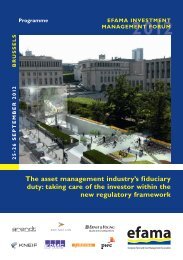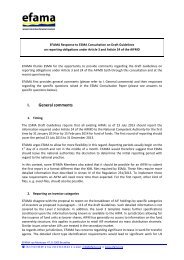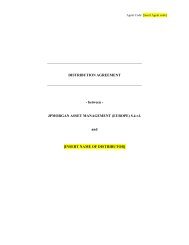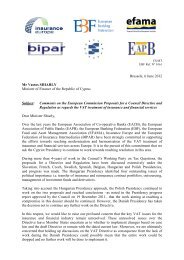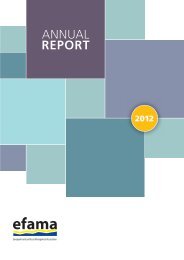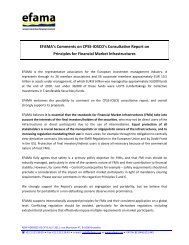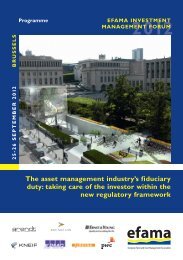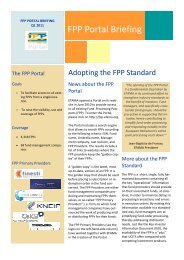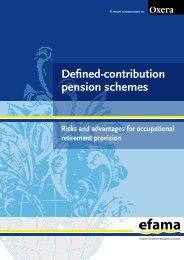EFAMA KPMG Solvency II Report
EFAMA KPMG Solvency II Report
EFAMA KPMG Solvency II Report
Create successful ePaper yourself
Turn your PDF publications into a flip-book with our unique Google optimized e-Paper software.
4 WORKING GROUP FINDINGS | 45<br />
Property<br />
Property can attract 25% capital requirement but there is uncertainty regarding<br />
treatment of ‘look through’ and leverage for indirect investments.<br />
Alternative assets<br />
This is a very broad definition which encompasses high risk ‘hedge funds’ and lower<br />
risk total return funds as well as less mainstream assets such as commodities and<br />
farmland. In order to achieve attractive capital treatment, the ability to look through<br />
these types of funds /assets, to ascertain the true underlying exposures will be<br />
essential and will need to be provided within timescales that comply with <strong>Solvency</strong> <strong>II</strong><br />
reporting requirements.<br />
The calibration of capital within different risk modules could lead to insurers making<br />
meaningful changes to their business strategies. For example, if underwriting risk<br />
were considered to be treated more favourably than market risk, insurers might seek<br />
to operate investment strategies which are much lower risk, freeing up capital to be<br />
used for underwriting risk or vice versa.<br />
Insurers will need to consider how and when they hold capital intensive assets – this is<br />
likely to lead to more active asset allocation policies, where exposure to certain assets<br />
(e.g. equity) becomes more dynamic as and when market conditions appear conducive<br />
to out-performance of the asset class, rather than adopting a more ‘long-term buy-andhold’<br />
approach and holding the full capital requirement throughout.<br />
Generally, <strong>Solvency</strong> <strong>II</strong> is likely to lead to an increased focus on Asset and Liability<br />
Management (ALM) with insurers seeking to hedge unrewarded risks where it<br />
is cheap and efficient to do so. However, there is still a considerable amount of<br />
uncertainty about the final regulations and insurers are unlikely to make signifi cant<br />
changes to their investment strategies until rules are finalised. The exception would<br />
be for strategies which provide an obvious short-term benefit and which can easily<br />
or cheaply be reversed if required.<br />
The wider market impacts are difficult to assess at this stage but potentially include:<br />
• Reduced appetite for longer-dated bonds which may conflict with banks’ intentions to<br />
increase the amount of funding from longer dated assets with longer-dated assets,<br />
although considerable overlap should still exist<br />
• Pro-cyclicality risks remain unaddressed despite the existence of the symmetric<br />
adjustment mechanisms for equities and corporates. In particular, the amount of<br />
discretion provided to the regulator in determining whether market conditions meet<br />
the requirements for a period of stressed financial markets and hence when the<br />
counter-cyclical premium could apply leaves a lot of ambiguity and uncertainty<br />
for insurers<br />
• A greater consistency among asset exposures where there is a reduced number<br />
of alternative assets that are suitable for insurers for reasons of capital effi ciency<br />
or transparency<br />
© 2012 <strong>KPMG</strong> LLP, a UK limited liability partnership, is a subsidiary of <strong>KPMG</strong> Europe LLP and a member fi rm of the <strong>KPMG</strong> network of independent member fi rms affi liated with <strong>KPMG</strong> International<br />
Cooperative, a Swiss entity. All rights reserved.




